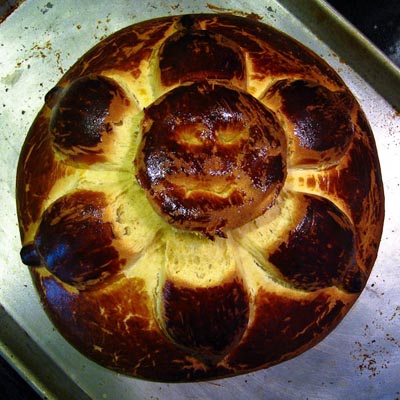Dia de los Muertos has to be one of the more interesting holidays out there. Since it’s celebrated on November 1st and 2nd, I have to wonder why it’s not Dias de los Muertos, but who am I to quibble. The holiday is celebrated in Mexico as a way to honor family members and friends who’ve passed away. Custom holds that the dead are easier to communicate with at the this time, and to entice them to do so, offerings are made of favorite foods and drinks. Often, these offerings include Pan de Muertos.
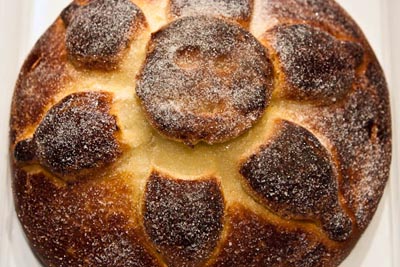
Pan de Muertos is a sweetened yeast bread. Typically it is formed into a round boule shape, often decorated with dough shaped into a skull and bones.
Recipes vary widely, but the one I chose to make is from Diana Kennedy, in her book From My Mexican Kitchen: Techniques and Ingredients
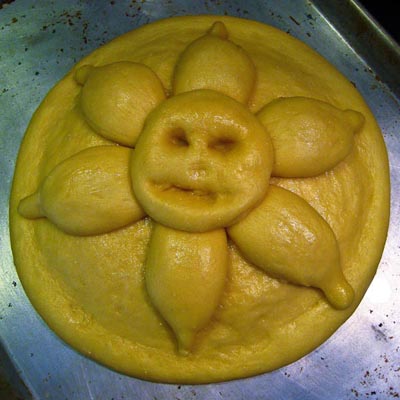
Kennedy’s Pan de Muertos recipe, for instance, covers four pages and many of the dough shaping steps are displayed, which is helpful. It took two days to complete it (she recommends letting the dough rest overnight), but in the end, the results were picture-perfect. A couple months ago or so, I bought a KitchenAid mixer finally (mostly so I could use the grinder attachment for sausage), and I will say, it was absolutely the best tool for the job of mixing the starter and the dough. They’re very sticky, and I firmly believe that mixing them by hand would have driven me to madness, at least for a little while.
The egg-enriched dough was soft and just a little bit sweet and accented by the tiniest hint of citrus from a splash of orange oil added toward the end of the dough constructing process (Kennedy recommends orange flower water or orange zest, but the orange oil worked very nicely for me). The bread’s sugary coating rested against a dark, almost bitter crust, and has been serving as the perfect complement to my morning cup of coffee (and my afternoon cup of tea) for a couple days now.
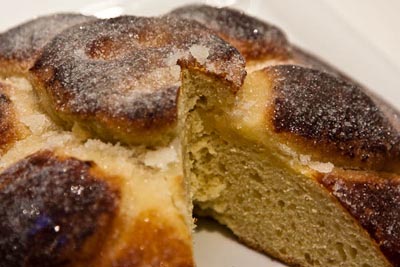
On this most recent November 2nd, I chose to remember my dead relatives while keeping very busy in the kitchen, filling the house with the wonderful smells of baking bread.
Starter:
Dissolve the yeast in the warm water and set aside. Add the flour, salt, and sugar to the bowl of a stand mixer. With the mixer running, add first your yeast mixture and then your beaten egg. Continue mixing until the dough starts to climb up the dough hook – around five minutes. The dough will still be sticky, but will have a smooth, elastic feel.
Set aside in a greased bowl covered with plastic wrap until the dough has doubled in volume – 1 ½ to 2 hours.
Dough:
Once the starter has finished rising, tear it into pieces and add it to the stand mixer. Add the sugar and the softened butter and mix till thoroughly combined.
Mix in the flour and beaten yolks in alternating additions. Add in the water and the orange oil and again mix till thoroughly combined. The dough should be sticky but smooth and able to just hold its shape.
At this point, either let the dough rise again as before, or place it in the refrigerator overnight to allow the flavors time to develop.
Once the dough has risen a second time, or the refrigerated dough has come to room temperature and finished its rise, it’s time to shape the dough. First grease a baking sheet and set it aside. Cut out ¼ of the dough and set it aside – this will become the bones and skull. Shape the remaining ¾ of dough into a smooth ball, then flatten it out on the baking sheet into a roughly 8-inch circle. Use the edge of your hand to press a rim around the outside edge of the dough, as Ms. Kennedy says, “like the brim of a hat.”
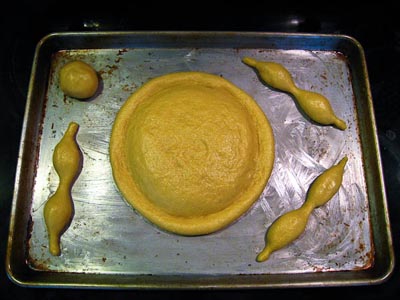
Quarter the reserved piece of dough. Roll one of the quarters into a smooth ball and move to the baking sheet. The remaining three pieces will be the bones. Roll each of these pieces into an 8-inch length, taking care to form a bone knob into each half of the length as shown below. As each piece is formed, move it to the greased baking sheet.
Once finished, cover the dough pieces on the baking sheet with greased wax paper and set aside for an hour or two to allow a good rise.
Preheat the oven to 375 degrees (F). Place the three bones across the main loaf at regular intervals, overlapping their centers. Insert the round ball into the dent in the middle of the bones and poke out eye-hole dents with the tip of your finger. (As you can see from the photo, I thought it would make sense to make a mouth dent also. This appears to have been a mistake as mine is more reminiscent of a happy-face than a skull.)
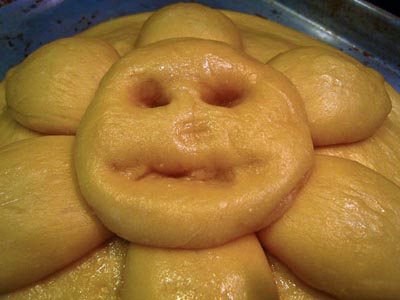
Brush the loaf with the beaten egg yolks of the glaze and bake for 15 to 30 minutes. The yolks to have turned a very dark brown and the loaf should spring back when pressed. Remove from the oven to a cooling rack. Brush with melted butter and sprinkle with sugar. Allow to cool completely before cutting into the loaf – 1 to 2 hours.
